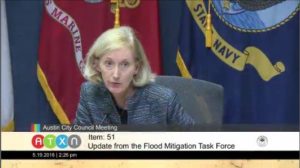Years after deadly storms, city still lacks comprehensive flood policy
Friday, May 12, 2017 by
Nina Hernandez In the wake of devastating flooding over Memorial Day Weekend in 2015, City Council established the 22-member Flood Mitigation Task Force to examine the city’s flood preparedness and come up with a list of recommendations for how to better prepare for the next major flood event – an eventuality in what is known as flash flood alley.
It didn’t take long for the inevitable to occur again. In the middle of that process, the Halloween floods rolled in, pummeling areas of Austin – particularly Onion Creek – all over again. Elloa Mathews, one of the task force members, recalled the chaos it created.
“People from the Halloween flood two years before had not finished fixing their houses from that flood and still had open permits to finish the repair work,” Mathews told the Austin Monitor. “And then they got flooded again, and couldn’t get the new permits because the old permits hadn’t been closed.”
It took the task force nine months of sifting through materials and working with staff to create the 91-page final report it released last May. Where other reports might have languished, task force members continue to push for action on their list of suggestions. Some continue their work as the Flood Mitigation Action Group – an informal group of former task force members who committed to sticking with the issue.
Mathews said many of the members that stayed engaged were impacted by the suffering and destruction they witnessed. “It was really the thought that these are our neighbors, and we’ve got to help them,” Mathews, a member of that group, said. She said it was impossible to have flood amnesia when she remembered the faces of Josefina Rodriguez and her baby Jay, who died in the 2013 flood.
That determination didn’t waver in the face of the massive financial obstacle in the way.
“Every reasonable person wants to be a good steward of our money,” said Dorsey Twidwell Jr., another task force member, last summer, “but this is a public safety issue, and this is a huge infrastructure issue. And it’s not going to get better unless there’s money spent on it.”
 Council Member Ann Kitchen said it’s unusual for a task force to remain active after the release of its final report. “Most task forces … once they’ve done their report, they disband,” she told the Monitor in April. “(The Flood Mitigation Task Force has) done an amazing amount of work in a very short time.”
Council Member Ann Kitchen said it’s unusual for a task force to remain active after the release of its final report. “Most task forces … once they’ve done their report, they disband,” she told the Monitor in April. “(The Flood Mitigation Task Force has) done an amazing amount of work in a very short time.”
In the year since the task force wrapped, much has been done on the city and county level to address the flood control situation in the region. But just how much progress has been made in that time? Which of the task force’s recommendations are likely to be implemented? And just where is the city going to find the money to do so?
TARGETED SOLUTIONS
One of the first things Council did was increase the budget for the Watershed Protection Department. The task force recommended beefing up the department’s Operations and Maintenance budget and adding additional staff and resources to address flooding.
Council heeded that advice in September, allocating $94.5 million for the department – a $9.3 million increase from the year before. That added 35 positions, which Watershed was given to – among other things – expand its crew size and address its service backlogs.
The increase in funding meant Watershed has more in-house crews at its disposal. “(Those crews) can do some of these more targeted solutions for localized flooding – upgrading pipe, installing new inlets, fixing eroded streambanks,” Erin Wood, a principal planner at the Watershed Protection Department, told the Monitor. “And we’re going to have to really develop (how we look) at our delivery of projects and how we can get more smaller projects through, in addition to our larger capital projects.”
Beyond additional resources for Watershed, the task force also called for the creation of a flood control district that would encompass the city and surrounding counties. The Travis County Commissioners Court recently approved an interlocal agreement with Hays County, and the city of Austin is looking into the possibility of signing on.
Kitchen said the collaboration would involve all of the jurisdictions working together to take a holistic look at the engineering and planning work each entity has already completed. They could then collectively decide how to proceed and which mitigation projects to prioritize.
Kitchen said the city is still working on an engineering study into possible solutions for the Onion Creek Watershed, and that Travis and Hays counties commissioned similar studies. All of that analysis has to be completed before the entities can decide whether or not to go forward with a formal flood control district.
Travis County Judge Sarah Eckhardt told the Monitor the flood control district is a possibility, but not a foregone conclusion. The major benefit of creating such a district would be that it creates an alternative revenue source to tackle large-scale projects, because each jurisdiction would pony up funds.
But if the flood control district doesn’t happen, Eckhardt said the region is still working together on mitigation strategies. “Even without a flood control district, we as governmental entities can partner up as we have under this (interlocal agreement) to do projects that cross county lines and that cross municipal lines,” she said.
THE ONE PERCENT
On the same day it passed the interlocal agreement, Travis County also gave the go-ahead for three flood control projects. One was half a million dollars in funding for the Arroyo Double/Twin Creeks Drainage Retrofit, another drainage retrofit for Thoroughbred Farms and $2.5 million for a 14-home buyout on Citation Avenue in Thoroughbred Farms.
The projects are a confirmation that the county is working on flood mitigation despite the uncertainty around a formal flood district. Thoroughbred Farms is also an example of just how hard it is to plan for these events. Those homes, according to Eckhardt, weren’t in the initial Federal Emergency Management Agency flood plain map.
“You also have other properties that are currently not in the flood plain that flooded,” Eckhardt said, “because it was the 100-year flood event that FEMA keys off of. Currently there is a less than 1 percent probability of them flooding, and yet they flooded twice in close succession.”
The same thing can be said inside the city. Places inside the urban core that hadn’t dealt with flooding in the past have been hit recently. Eleanor McKinney, a member of the city’s CodeNEXT Advisory Group, said the city has to take that climate change into account when it comes to regulating redevelopment under the city’s new Land Development Code.

“Since our climate is changing we have to be able to respond,” McKinney told the Monitor. “And we have discovered that … without these practices redevelopment is contributing to localized flooding.”
According to Wood, infill redevelopment does contribute to localized flooding. One thing the city could see under CodeNEXT is a requirement that redevelopment include flood mitigation measures. This week, the Planning Commission heard a staff briefing on the task force recommendations, specifically those dealing with CodeNEXT and capital improvement projects. Several task force members were in attendance. Staff acknowledged it would require a community-wide conversation to figure out how to implement the on-site detention requirement in particular, which currently only applies to new construction.
Another key task force recommendation was that the city make the task force a permanent entity. Some members of the informal Flood Mitigation Action Group are working to get already vetted capital improvement projects funded as soon as possible. Other members advocate to keep their flood-ravaged neighborhoods together, Mathews said.
The request for an official, city-sanctioned group was partially accommodated; members of the Flood Mitigation Task Force were appointed to the Drainage Infrastructure and Flood Mitigation Committee, an Environmental Commission subcommittee dedicated to making recommendations on city drainage infrastructure and flood mitigation practices, among other duties.
That committee is also tasked with examining the Flood Mitigation Task Force final report and ensuring that recommendations under the Environmental Commission’s purview are fully considered. The chairs of the task force’s three working groups – Buyouts, Operations and Maintenance, and Capital Improvement Projects – were given non-voting spots on the committee through 2021.
“We’re just an advisory commission, so we can’t do it ourselves,” Environmental Commission Chair Marisa Perales told the Monitor, “but we want to follow along. We want to make sure that something is being done. That it’s not just being kind of left out there. I think that’s going to be something that’s going to be ongoing for Environmental Commissions for years to come.”
‘WHO IS PUSHING THE DRAINAGE BOND?’
The task force report also called for a drainage bond later in 2016, but that was the summer Mayor Steve Adler was shepherding the $720 million mobility bond to a November vote. The report noted that there hasn’t been a drainage bond since 2006.
Council decides the election date for each bond package. Kitchen said that last year it seemed like there might be time to prepare a proposal for voters in 2017. “It’s rapidly becoming apparent that it’s not (enough time),” she said.
The next time a drainage package could go before voters is 2018. It would first have to go through the Bond Oversight Commission and then through Council for consideration.
Adler’s stewardship was essential in getting the mobility bond passed. Mathews hopes for a similar champion to emerge when it comes to drainage bonds in particular. Without a concentrated effort to secure funding for the massive amount of work that needs to be done – $700 million in drainage infrastructure alone – Mathews doesn’t see the concentrated effort the task force envisioned when it wrapped its final report last year.
“Who is pushing the drainage bond?” she asked. “It’s about somebody saying, ‘It’s a priority.’”
You're a community leader
And we’re honored you look to us for serious, in-depth news. You know a strong community needs local and dedicated watchdog reporting. We’re here for you and that won’t change. Now will you take the powerful next step and support our nonprofit news organization?








